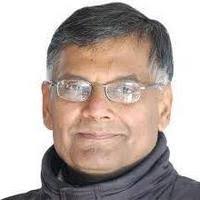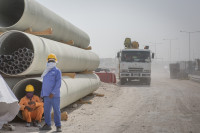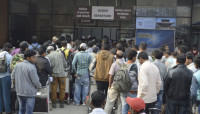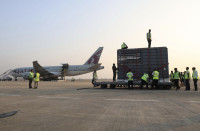Columns
A lament for lost opportunities
The excitement of achievement in 1990 turned out to be a rather short one.
CK Lal
It's Baisakh once again, the first month of the Bikram Era that usually falls in April. Yearning for a new beginning, TS Eliot grieves in his most famous poem: 'April is the cruellest month, breeding / Lilacs out of the dead land, mixing / Memory and desire, stirring …’ Wails of the immortal verse resonate with broken dreams and dashed hopes of common Nepalis over last three decades.
The first Jan Andolan in 1989 had started on a high note. Though not exactly green, the Kathmandu Valley was still largely clean in the spring of 1990. Despite bad roads, inadequate water supply, insufficient cooking gas, inefficient garbage collection and undependable electricity, the air was thick with exuberant hope in the Kathmandu Spring. The People's Movement had just forced king Birendra to restore parliamentary democracy after a hiatus of three decades when monarchs had ruled the country with an authoritarian hand in a developmental glove.
The composition of the interim cabinet of the restored system had succeeded in igniting unbridled optimism. Prime Minister Krishna Prasad Bhattarai had the reputation of being an adroit designer of principled compromises. His senior-most cabinet colleague as the Deputy Prime Minister was Sahana Pradhan, a 'democratic' communist of long-standing in national politics.
Prismatic societies on the path of democracy are saddled with a huge mismatch between their political aspirations and social realities. Touted as the best charter in the world, the Constitution of the Kingdom of Nepal 2047 (1990) was aimed at institutionalising parliamentary democracy with constitutional monarchy. However, unable to establish parliamentary supremacy, it ended up creating dual centres of power.
The monarchy retained complete control over the national army through its dominance over the National Defence Council. Recommendations of the cabinet weren’t made sufficiently explicit for the appointment of ambassadors. The anachronism of Raj Parishad (the Royal Council) was retained. The Narayanhiti Palace maintained its predominance over the permanent establishment even as the cabinet secretariat tried to assert its legitimate authority.
Diminished dreams
The excitement of achievement in 1990 turned out to be a rather short one. Besieged with internal contradictions and external machinations, the interim cabinet was unable to exercise its popular legitimacy to initiate the transformation of society and polity. Stalwarts of the transitional politics, including Prime Minister Bhattarai, lost parliamentary elections.
When Girija Prasad Koirala formed the first elected government after 30-years, hope returned that his party will use its popular mandate to commence the practice of progressive politics in a democratic manner. All such expectations were soon dashed. With a nudge from the royal palace, the permanent establishment began to assert itself. In the name of containing communism, international actors began to cultivate their loyalists independent of the government through non-governmental organisations.
The Marxist-Leninist party in the opposition took to the streets within days of the formation of a new government on flimsy pretexts. The judiciary cut the wings of the executive sphere of the state and delimited the government's authority of implementing international agreements without the ratification of the legislature. A ginger group of the ruling party began to conspire for its fall. Hemmed in from all sides, Prime Minister Koirala began to rely solely upon his kitchen cabinet, most of them unelected busybodies with vested interests, for administrative advice. It was a sure-fire recipe for political disaster.
A considerable section of the profit sector had prospered in the dying days of the monarchical rule through the Structural Adjustment Programme (SAP) of international lending agencies. Such beneficiaries of the Washington Consensus began to exercise a tremendous influence upon the Koirala coterie. A government elected on the promise of introducing a socialist agenda was caught in the web of its own contradictions and fell with a thud without initiating any new programme.
The midterm elections of 1994 threw up an unusual winner—the Communist Party of Nepal (United Marxist-Leninist). Better known by its acronym UML, the party was culturally conservative, socially revisionist, politically conformist and economically reformist. It transformed the political landscape in Nepal as the nationalism, xenophobia and jingoism of the early-1960s made a spectacular comeback. The combustible composition continues to rule the roost in the form of demagogic populism to this day.
Almost out of nowhere, a certain Khadga Prasad Sharma Oli took the centre stage as the Home Minister of the minority government in 1994 as an associate of the de jure Deputy Prime Minister but de facto executive head Madhav Kumar Nepal. With a combination of Stalinist determination, Leninist ingenuity and Chanakyan chicanery, Oli would slowly but surely outwit Nepali Congress, outfox the Maoists, and outmanoeuvre his challengers within the UML to capture the state and run it as his fief.
The Maoist insurgency (1996-2006) decimated all hopes of a peaceful transformation of the political economy. The Narayanhiti Massacre of June 1, 2001 closed all avenues of retaining the constitutional monarchy. All that was left of the progressive dream of April 1990 after the royal-military coup of February 1, 2005 was a republican aspiration.
Broken promises
The April Uprising of 2006 could have led to a genuine Rhododendron Revolution. But politicos that had little or no role in the republican struggle such as Sushil Koirala and Sher Bahadur Deuba along with their conservative coteries in the Nepali Congress began to pull GP Koirala away from the Maoists.
The regressive forces in the UML began to regroup around wily Oli. Hubris took over Pushpa Kamal Dahal as he began to fancy himself as a leader bigger than the principal signatory of the 12-point understanding who had saved him from complete decimation. When Nepal went to the polls to form the first constituent assembly in its history, it was akin to 'night-bitten dawn' with uncertainties about the future of federalism and inclusion.
When the Gorkha Earthquakes struck Nepal in April 2015, there was hope that the political regime will prioritise the rescue, relief and rehabilitation efforts above everything else with the help of the international community. The permanent establishment thought so little of then prime minister Sushil Koirala that it didn't deem it fit to report him of the disaster. He found out about the quakes from the Twitter post of the Indian Prime Minister Narendra Modi.
Meanwhile, the de facto premier Oli had begun to exercise his unofficial authority without legal or moral responsibility to prepare the ground for the 16-point conspiracy with the help of international interlocutors from friendly countries. In the middle of the aftershocks, a deal was sealed to junk all the work done by the first constituent assembly and rush a charter through fast-track without any deliberation on the basis of party whips.
All the promises of April 2006 were buried unsung in the debris of the massive earthquakes. Had it not been for a court ruling, aspirations of federalism would have been laid to their final resting place in the cupboards of Singha Durbar.
When the world was coming to terms with the first pandemic of the century in April 2020, Supremo Sharma Oli, by then the uncrowned chieftain of the dominant Khas-Arya community, was serving homilies instead of leading from the front to face the calamity. The economy went into a tailspin as disaster capitalism spread its fangs. He is back to peddling mistruths as the second wave of Covid-19 takes Nepal in its grip.
There isn't much to be happy about this Baisakh, but Happy New Year BS 2078 anyway: May we all have the energy to fight for truth and justice all over again.




 11.12°C Kathmandu
11.12°C Kathmandu













%20(1).jpg&w=300&height=200)

